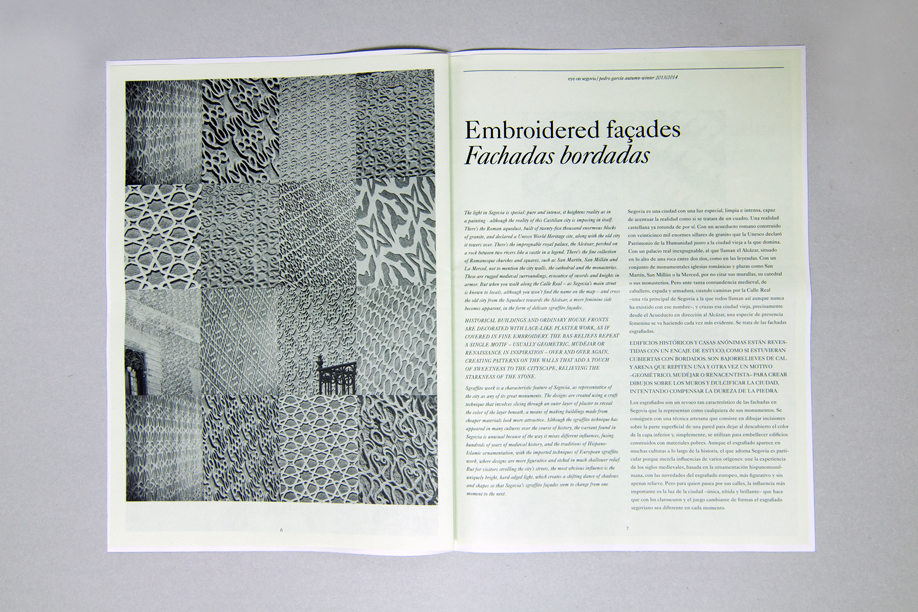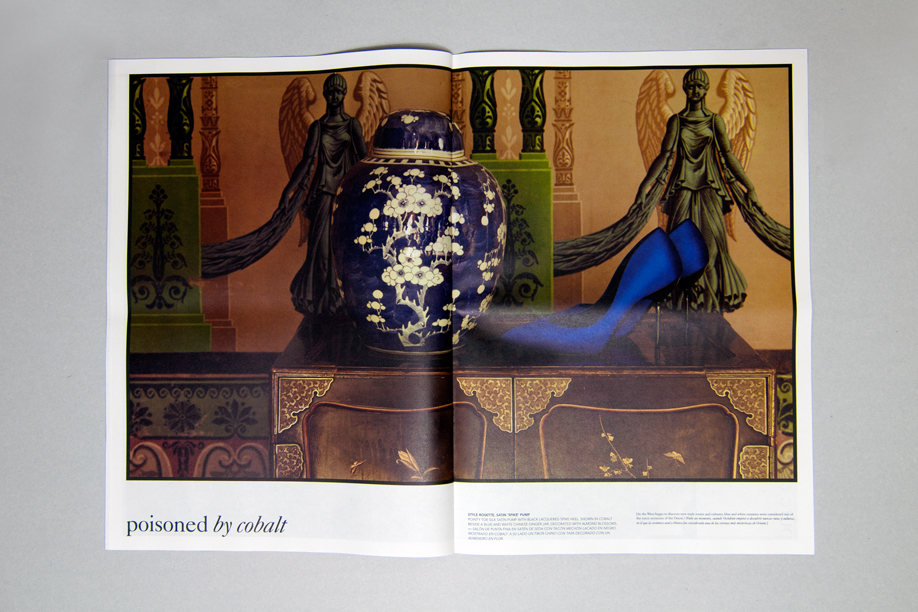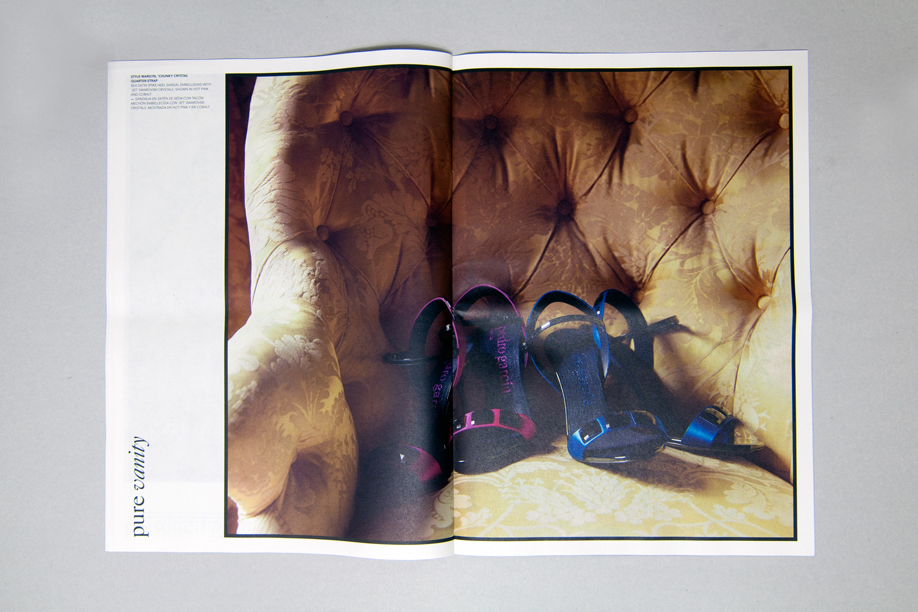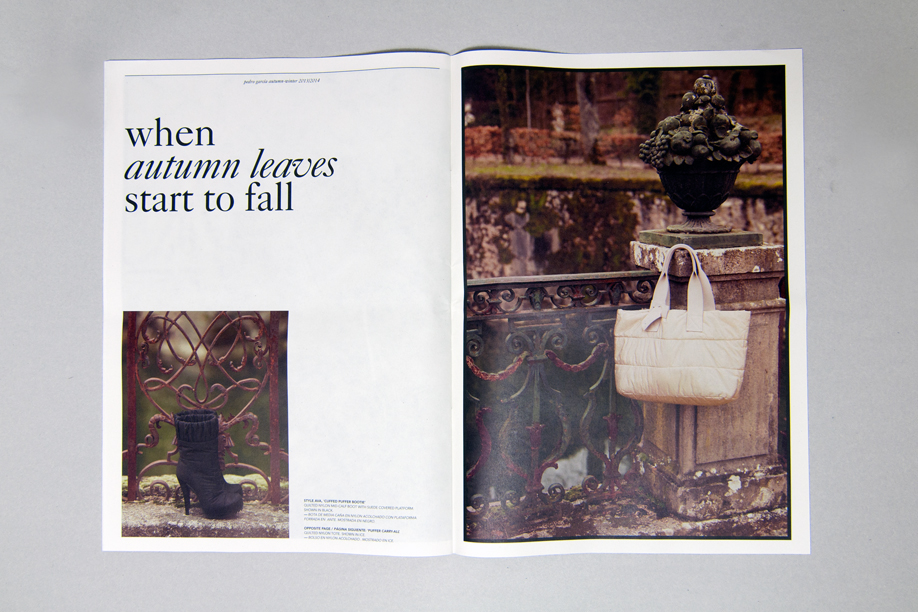Singular, Inspiring, Unique Spain
We’ve been involved in Pedro García’s "Made in Spain" series of catalogs since it's launching in 2010. From the beginning our objective was to offer the personal vision of the brand of a selected geographical location within Spain. But now, with our new editorial concept and its newspaper-style format the brand catalog has taken a whole new dimension. The intention is clearer, and the editorial content can go deeper. It has much more content that is either concentrated in the central section or interspersed with photographs of the collection. In each catalog we are in charge of selecting and writing the contents that find what is most characteristic, unique and inspiring in every place. Apart from the features we are also in charge of all the copywriting of the product spreads. For the first edition of the new format the locations chosen were Baroque Segovia and La Granja de San Ildefonso. The main articles were on The Royal Glass Factory of La Granja and the sgraffito work in the façades of the buildings in Segovia. The art direction and graphic design is by Daniel Ayuso for clase bcn.
We’ve been involved in Pedro García’s "Made in Spain" series of catalogs since it's launching in 2010. From the beginning our objective was to offer the personal vision of the brand of a selected geographical location within Spain. But now, with our new editorial concept and its newspaper-style format the brand catalog has taken a whole new dimension. The intention is clearer, and the editorial content can go deeper. It has much more content that is either concentrated in the central section or interspersed with photographs of the collection. In each catalog we are in charge of selecting and writing the contents that find what is most characteristic, unique and inspiring in every place. Apart from the features we are also in charge of all the copywriting of the product spreads. For the first edition of the new format the locations chosen were Baroque Segovia and La Granja de San Ildefonso. The main articles were on The Royal Glass Factory of La Granja and the sgraffito work in the façades of the buildings in Segovia. The art direction and graphic design is by Daniel Ayuso for clase bcn.
To read the original texts in Spanish clic the link below.


Loco Barroco
Baroque grandeur. Excessive and ever so slightly unhinged. That’s La Granja de San Ildefonso. A small town, one hour from Madrid, on the slopes of the Sierra de Guadarrama, dominated by a breathtaking royal palace and its Versailles-like gardens. A town whose courtly architecture includes an 18th-century glass factory that was built to supply the palace, where delicate crystal glassware is made with the same techniques that were employed three centuries ago. And the refined traditional craftsmanship seen in glass-blowing resurfaces in the sgraffito façades of the old city of Segovia, the provincial capital. Houses and other buildings are swathed in decorative plasterwork as intricate as lace. On this journey, among Gallic-style gardens and heraldic house-fronts, we found quirky, inspiring and outstanding locations, some of them a perfect match for our collection and others standing in radical contrast. But we also had time to discover a charming, intriguing region, with candies that taste of flowers, sheep that can trace their roots back three thousand years, and urban-dwelling storks. Welcome to Pedro García’s Segovia.




Above: Style Ariela, ‘glitzy velvet ballerina’ – Soft cotton velvet ballerina embellished with multicolor swarovski crystals. Shown from left to right in carambola, cameo and amparo blue.
Below: Detail of a rare surviving example of the work of the Royal Wallpaper Factory (Madrid 1788-1834).


Style Audrey, ‘squashy paillette ballerina’ – Soft sequined ballerina with matching knit bow. Shown in cupcake displayed on a pompadour-pink ceramic dish in a Rococo style, which is decorated with romantic motifs and mounted on a bronze coquille. In the background, another example of eighteenth-century wallpaper produced at the Royal Factory in Madrid.
Historically, brilliant colors like pink were difficult to produce and highly expensive: they became a visible mark of class and nobility, affordable only by the aristocracy.




The Royal Glass Factory of La Granja
Brilliance that never fades
Once upon a time there was a Spanish monarch, the grandson of the Sun King of France, who was nostalgic for his childhood at Versailles, and decided to build a Baroque palace in Segovia, high in the Sierra de Guadarrama. The site he chose was the small monastery known today as La Granja de San Ildefonso. To ensure that his palace had windows and mirrors, fine glassware and crystal chandeliers, Philip V – the king in question – ordered the creation of a Royal Glass Factory. And that is where our story begins, because today, three centuries after it first opened, the factory is still producing exactly the same glasses, decanters, candelabras and delicate eighteenth-century objects of all descriptions, in the finest crystal. Unique works of craftsmanship that are still blown, engraved, gilt and enameled by hand by master glassmakers, using age-old techniques that require no machinery, so that kings and commoners alike can enjoy the refinement of the eighteenth century in the digital maelstrom of the twenty-first.
All this is thanks to the work of the National Glass Center Foundation, founded in 1982, which has won the Royal Glass Factory of La Granja an international reputation in the world of glassmaking. As well as its educational programs and museum, it has renovated some two thousand original moulds: in other words, it has enabled the factory to reproduce two thousand pieces from the eighteenth and nineteenth centuries. With an eye on the twenty-first century, the factory also works with contemporary brands and designers. ‘The foundation’s ultimate goal is to revive glassmaking as a trade and to secure international recognition for the quality and workmanship of a Spanish craft that flourished at a particular moment in European history,’ explains Pilar López, the foundation’s administrative director. ‘We want to establish the Cristal de La Granja brand as a byword for Spanish glassmaking, within the Made in Spain range of products.’


Embroidered façades
The light in Segovia is special: pure and intense, it heightens reality as in a painting - although the reality of this Castilian city is imposing in itself. There’s the Roman aqueduct, built of twenty-five thousand enormous blocks of granite, and declared a UNESCO World Heritage site, along with the old city it towers over. There’s the impregnable royal palace, the Alcázar, perched on a rock between two rivers like a castle in a legend. There’s the fine collection of Romanesque churches and squares, such as San Martín, San Millán and La Merced, not to mention the city walls, the cathedral and the monasteries. These are rugged medieval surroundings, evocative of swords and knights in armor. But when you walk along the Calle Real – as Segovia’s main street is known to locals, although you won’t find the name on the map – and cross the old city from the Aqueduct towards the Alcázar, a more feminine side becomes apparent, in the form of delicate sgraffito façades. Historical buildings and ordinary house fronts are decorated with lace-like plaster work, as if covered in fine embroidery. The bas-reliefs repeat a single motif – usually geometric, Mudéjar or Renaissance in inspiration – over and over, creating patterns on the walls that add a touch of sweetness to the cityscape, relieving the starkness of the stone.
Sgraffito work is a characteristic feature of Segovia, as representative of the city as any of its great monuments. The designs are created using a craft technique that involves slicing through an outer layer of plaster to reveal the color of the layer beneath, a means of making buildings made from cheaper materials look more attractive. Although the sgraffito technique has appeared in many cultures over the course of history, the variant found in Segovia is unusual because of the way it mixes different influences, fusing hundreds of years of medieval history, and the traditions of Hispano-Islamic ornamentation, with the imported techniques of European sgraffito work, where designs are more figurative and etched in much shallower relief. But for visitors strolling the city’s streets, the most obvious influence is the uniquely bright, hard-edged light, which creates a shifting dance of shadows and shapes so that Segovia’s sgraffito façades seem to change from one moment to the next.

It’s known as ‘la Casa de Los Picos,’ the House of Points, because its façade is completely covered in stones that resemble giant tacks: blocks of granite carved into diamond-shaped spikes. Pure medieval punk, and without doubt one of the most striking monuments in Segovia’s old town. The building currently houses Segovia’s Higher School of Art and Design. It couldn’t have found a better location.

Style Rosette, satin ‘spike’ pump – Pointy toe silk satin pump with black lacquered spike heel. Shown in cobalt beside a blue and white chinese ginger jar, decorated with almond blossom. As the West began to discover new trade routes and cultures, blue and white ceramics were considered one of the rarest mysteries of the Orient.


Below: Style Sully, ‘churra lambskin boot’ – Open-toe fur boot in churra lambskin. Shown in black.
Opposite page: Style Saskya, ‘churra lambskin ankle boot’ – Open-toe fur ankle boot in churra lambskin. Shown in black. In the background, an aristocratic Spanish family’s pet dog, in a painting by Manuel García, ‘Hispaleto’ (Seville, 1836 – Madrid, 1898), a painter known for his portraits and paintings of everyday life, as well as historical and literary scenes.
The term “Baroque” was first used by later critics who wanted to ridicule the popular styles of the 18th century. “Baroque” originally meant grotesque or absurd.





Hip hip churra!
They say the eyes are the mirror of the soul, and in the case of the churra lamb – with its black and white mask, like a Harlequin’s – they’re absolutely right. It’s a lively, hardy breed, able to walk for miles, as well as being one of the oldest on the Iberian peninsula, with a history that can be traced back over 3000 years. In the Duero valley, in the north of the province of Castile, it can be found grazing freely. Every part of the sheep has a use, but it’s the quality of its wool that makes Spain one of its biggest exporters. This season, the long, soft fleece of this pure breed is used in our Sully and Saskya styles. Hurrah for the churra!
Shrinking Violets
Sold all over Segovia, these traditional candies are shaped like five-petaled flowers and made from essence of violets – hence their old-fashioned flavor, fit for a refined gathering at the Royal Court. Perhaps this is why they were Alphonse XIII’s preferred gift to his lovers, although, paradoxically, violets are a symbol of modesty.

Happily ever after
They’re big, with a wingspan of up to two meters, and their nests weigh three metric tons - which is a heavy load for historic buildings to support. But the sixty-four nesting pairs of storks recorded in Segovia are respected by all the city’s residents. Whether because they’re a symbol of wellbeing and their presence is a good omen, or because of their monogamous habits, they have become one of the city’s most characteristic birds.


